The Dissolution of a Soluble Layer
Karst. Now there's a word I don't think I'd ever heard before arriving in Southeast Asia. It's a word that kept coming up as I traveled through the region. And in Northeastern Vietnam, at a UNESCO World Heritage site called Halong Bay, the experience is all about the karsts.
A karst, according to Wikipedia, is a geological term for a "three-dimensional landscape shaped by the dissolution of a soluble layer or layers of bedrock, usually carbonate rock such as limestone or dolomite." In layman's terms this means a natural feature such as a cave or a spire that's been whittled into shape over long years of erosion.
In Halong Bay, which is situated in the Gulf of Tonkin just south of mainland China, erosion has carved out a spectacular landscape in which nearly 2,000 small islands (more than 3,000 if you believe Lonely Planet) dot an emerald sea. Within some of these islands are extensive cave systems featuring massive stalactites. Halong Bay is one of those places that must be experienced; pictures cannot convey the majesty of the place. It is also said, at least in the tourism industry, that you cannot visit Vietnam without a night on a junk in Halong Bay.

Junks in Halong Bay
I had arrived in Hanoi tired and disgruntled, weary of the hassles that seem unavoidable in parts of Southeast Asia. I'd heard that Hanoi was a gem, a city to get lost in, the Paris of the East. When I arrived, however, it was the same old same old. "Same same," as the saying goes here.
Here's a short story to back up my position. I met an Australian on the flight from Hue to Hanoi. Terry - who so resembled Terry O'Quinn that I thought for a moment I was about to fly with a "Lost" castaway - and I chatted on the plane and then shared a taxi to the city's old quarter. We were quoted a price for the ride at the airport, but the driver doubled the figure as soon as we were on the highway (we paid the initial, fair price). We gave him a specific hotel, chosen at random from Lonely Planet, but he still took us to a hotel owned by someone he knew. We hadn't even stepped out of the taxi when a tout opened the passenger door, shoved a card into Terry's face and urged him to check out his hotel. We gathered our bags and started to walk down the street. Within 10 seconds three more touts were shoving brochures and color photographs into our faces, urging us to stay at their hotels. I ignored them, but Terry was too polite and kept saying "no, thank you" over and over. One tout was particularly persistent, and the hotel he was peddling looked nice, so we agreed to check it out. Once we arrived, however, the facade looked completely different from the facade in the picture. Terry said it wasn't the same hotel. The tout said they'd changed the name. I grabbed the brochure and checked the printed address against the address on the building. They weren't even close. Et cetera, et cetera.
Terry's time was limited and he booked a Halong Bay trip for the following day. I was still undecided and opted to explore the city instead. Twenty-four hours was all it took for me to decide to flee Hanoi for someplace more peaceful.
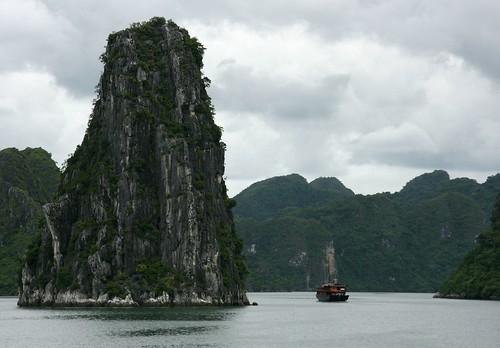
Halong Bay
Hanoi is a city overrun by the motorbike. As I understand it, four years ago, most of the population still used bicycles to get around. Now, cheap imports from China (US$500 will buy you a bike) have flooded the market and the streets, especially the narrow lanes of the old quarter, are choked with motorbikes. The noise of the engines, the constant honking of horns, and the din from the city itself combined with the omnipresent touts and hawkers pestering the tourists, not to mention the exhaust from all those motorbikes and the pollution and grim in general, were too much for me. What better than to end my Vietnam adventure, my entire Southeast Asia adventure in fact, than with a trip to Halong Bay?

Hanoi Motorbikes (Photo by Ian Stacey)
I signed up for a three day/two night tour with the Kangaroo Cafe, the only foreign-owned tour operator in Hanoi. (Unfortunately, there are no rules in Vietnam against copyright infringement, and Terry signed up for a Halong Bay tour with the fake Kangaroo Cafe.) The tour promised a night on a junk in Halong Bay and a night on Cat Ba Island, part of Cat Ba National Park. The third day would be spent on the road returning to Hanoi.
I think I was spoiled by my tour guides in Australia. They were personable and knowledgeable. Anything you asked them about the region, whether cultural, historic or scientific, and they had an answer. Time was spent educating their passengers about the regions we passed through. Every tour I took in Australia included information about geology, geography, history, botany, biology, meteorology, myths and legends, cultural trends, economics and other topics I just can't recall at the moment. I now believe all tours should be as much about receiving an education as traveling from point A to point B.
In Southeast Asia, the tune is different. I don't know if it's because of language barriers, cultural difference or a lack education on the part of the local guides. In Cambodia, my guide did the best he could telling us about the culture of modern Cambodia and the ancient culture of Angkor. But he seemed unable to deviate from a script when asked about industry or geography.
The guide for the trip to Halong Bay was Quy, a smiling young mother who'd been taking foreigners on this route for more than three years. Still, she chose to introduce herself and the trip with a lengthy monologue about marriage rituals in Vietnam and the importance of adhering to rituals for preserving and delivering good luck (e.g., women should only marry at 21, 23, 26 and 28).
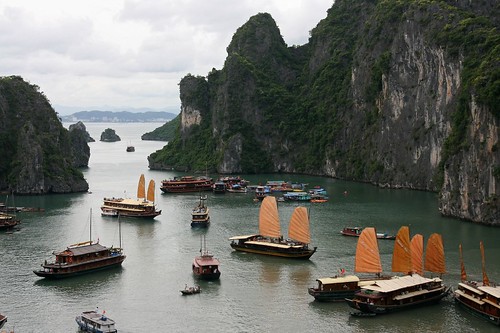
Junks
When we arrived in Halong Bay, everyone in the group seemed overwhelmed by the beauty of the place. Despite gray skies and cloud cover the entire time we were there, we are all impressed by the natural splendor. Our guide never touched on how the bay was formed, on what natural forces were at work to create this magical landscape. Instead she told us about the local legend surrounding its creation. You see, Halong means "where the dragon descends into the sea." So the story is that a dragon flew out of the sky, flicked its tail and carved out the bay. Simple as that.
When we visited Hang Sung Sot cave, a magnificent and extensive limestone grotto, we were told nothing about cave formation, nothing about stalactites and stalagmites, nothing about conservation or preservation in the face of increased tourism. Instead, we were directed to look at different rock formations and imagine them as animals, much like you might spend a lazy summer afternoon staring at clouds in the sky. There was the monkey rock, the elephant, the laughing Buddha, the monkey with the flat head. Quy called the cavern "Surprising Cave" because of a phallus-shaped rock that, she said, we would find surprising. The rock, by the way, was impressive; stark, red porno lighting added to the "surprise." To be fair to Quy, Sung Sot means "surprise" or "awe" in Vietnamese, so she didn't make up the name.
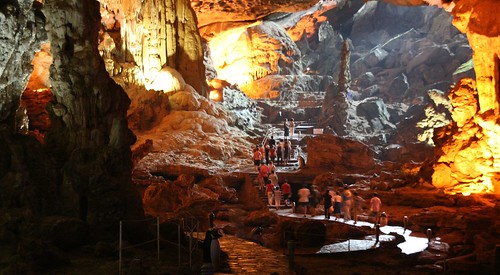
Hang Sung Sot Cave

Monkey With Flat-Top
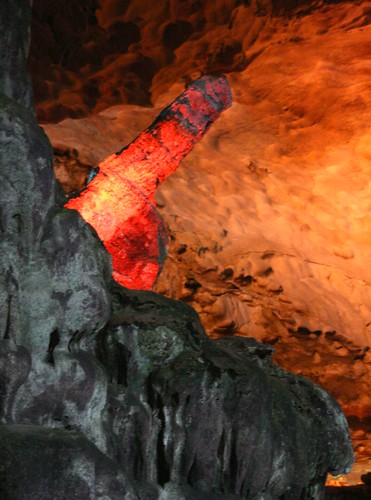
Cock Rock
The time I spent floating on a first-class junk in Halong Bay was relaxing and peaceful, the antithesis of the hectic streets of Hanoi. The second day of the tour was spent, unfortunately, visiting an unremarkable cave and an unremarkable island. The night was spent in the town of Cat Ba, a resort town stuffed to the gills with hotels, where there's little to do at night other than sing karaoke and avoid the touts offering "boom boom girl." The tour group did band together for a very fun night at the town's only western restaurant (where I ate the most disgusting pizza I've ever encountered), but everyone agreed that another night on the junk would have been better.
Still, the trip was everything I wanted in my final days in Vietnam and I'm glad I made the effort. But something is wrong. I don't quite know how to say this without sounding like a snob, or a judgmental foreigner. So I'm just going to say it.
I feel like the tourism industry in parts of Southeast Asia tries to give tourists what they think tourists want. But tourists want more than a night on a boat and a tour of a cave. They want to be educated about the places they visit. Why is it significant? What happened there? Did the city or town play any part in the war? What are the major industries? How many people live in the region? Is there an educational system? Are there artists? What do those weird things outside of every house?
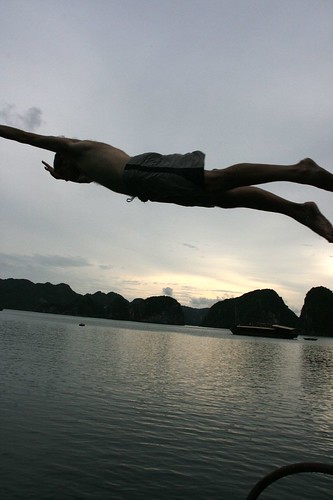
Fun in Halong Bay
I realize this could all come across as a lecture. It doesn't have to be. Imagine if all the energy expended on haggling with tourists, on trying to extort as much money as possible from them, was spent on a dialog. I was pestered from morning to night by people trying to sell me things. If I had been engaged in conversation by just a fraction of that number and given information about their lives and their country, my impressions would be much different. I felt like i was able to engage in conversation in Malaysia and Laos, in northern Thailand and parts of Cambodia. It didn't happen in Vietnam. Maybe I was just tired of the hassles of Southeast Asia after five months of travel. (By the way, this is also why there is a dearth of photos of Hanoi. I promise a return to photography now that I'm in Hong Kong.)
If you've got any experience or insight on the subject of travel in Vietnam or the developing world, post it here! This is the perfect time to contribute to the Packmonkey experience.
A karst, according to Wikipedia, is a geological term for a "three-dimensional landscape shaped by the dissolution of a soluble layer or layers of bedrock, usually carbonate rock such as limestone or dolomite." In layman's terms this means a natural feature such as a cave or a spire that's been whittled into shape over long years of erosion.
In Halong Bay, which is situated in the Gulf of Tonkin just south of mainland China, erosion has carved out a spectacular landscape in which nearly 2,000 small islands (more than 3,000 if you believe Lonely Planet) dot an emerald sea. Within some of these islands are extensive cave systems featuring massive stalactites. Halong Bay is one of those places that must be experienced; pictures cannot convey the majesty of the place. It is also said, at least in the tourism industry, that you cannot visit Vietnam without a night on a junk in Halong Bay.

I had arrived in Hanoi tired and disgruntled, weary of the hassles that seem unavoidable in parts of Southeast Asia. I'd heard that Hanoi was a gem, a city to get lost in, the Paris of the East. When I arrived, however, it was the same old same old. "Same same," as the saying goes here.
Here's a short story to back up my position. I met an Australian on the flight from Hue to Hanoi. Terry - who so resembled Terry O'Quinn that I thought for a moment I was about to fly with a "Lost" castaway - and I chatted on the plane and then shared a taxi to the city's old quarter. We were quoted a price for the ride at the airport, but the driver doubled the figure as soon as we were on the highway (we paid the initial, fair price). We gave him a specific hotel, chosen at random from Lonely Planet, but he still took us to a hotel owned by someone he knew. We hadn't even stepped out of the taxi when a tout opened the passenger door, shoved a card into Terry's face and urged him to check out his hotel. We gathered our bags and started to walk down the street. Within 10 seconds three more touts were shoving brochures and color photographs into our faces, urging us to stay at their hotels. I ignored them, but Terry was too polite and kept saying "no, thank you" over and over. One tout was particularly persistent, and the hotel he was peddling looked nice, so we agreed to check it out. Once we arrived, however, the facade looked completely different from the facade in the picture. Terry said it wasn't the same hotel. The tout said they'd changed the name. I grabbed the brochure and checked the printed address against the address on the building. They weren't even close. Et cetera, et cetera.
Terry's time was limited and he booked a Halong Bay trip for the following day. I was still undecided and opted to explore the city instead. Twenty-four hours was all it took for me to decide to flee Hanoi for someplace more peaceful.

Hanoi is a city overrun by the motorbike. As I understand it, four years ago, most of the population still used bicycles to get around. Now, cheap imports from China (US$500 will buy you a bike) have flooded the market and the streets, especially the narrow lanes of the old quarter, are choked with motorbikes. The noise of the engines, the constant honking of horns, and the din from the city itself combined with the omnipresent touts and hawkers pestering the tourists, not to mention the exhaust from all those motorbikes and the pollution and grim in general, were too much for me. What better than to end my Vietnam adventure, my entire Southeast Asia adventure in fact, than with a trip to Halong Bay?

I signed up for a three day/two night tour with the Kangaroo Cafe, the only foreign-owned tour operator in Hanoi. (Unfortunately, there are no rules in Vietnam against copyright infringement, and Terry signed up for a Halong Bay tour with the fake Kangaroo Cafe.) The tour promised a night on a junk in Halong Bay and a night on Cat Ba Island, part of Cat Ba National Park. The third day would be spent on the road returning to Hanoi.
I think I was spoiled by my tour guides in Australia. They were personable and knowledgeable. Anything you asked them about the region, whether cultural, historic or scientific, and they had an answer. Time was spent educating their passengers about the regions we passed through. Every tour I took in Australia included information about geology, geography, history, botany, biology, meteorology, myths and legends, cultural trends, economics and other topics I just can't recall at the moment. I now believe all tours should be as much about receiving an education as traveling from point A to point B.
In Southeast Asia, the tune is different. I don't know if it's because of language barriers, cultural difference or a lack education on the part of the local guides. In Cambodia, my guide did the best he could telling us about the culture of modern Cambodia and the ancient culture of Angkor. But he seemed unable to deviate from a script when asked about industry or geography.
The guide for the trip to Halong Bay was Quy, a smiling young mother who'd been taking foreigners on this route for more than three years. Still, she chose to introduce herself and the trip with a lengthy monologue about marriage rituals in Vietnam and the importance of adhering to rituals for preserving and delivering good luck (e.g., women should only marry at 21, 23, 26 and 28).

When we arrived in Halong Bay, everyone in the group seemed overwhelmed by the beauty of the place. Despite gray skies and cloud cover the entire time we were there, we are all impressed by the natural splendor. Our guide never touched on how the bay was formed, on what natural forces were at work to create this magical landscape. Instead she told us about the local legend surrounding its creation. You see, Halong means "where the dragon descends into the sea." So the story is that a dragon flew out of the sky, flicked its tail and carved out the bay. Simple as that.
When we visited Hang Sung Sot cave, a magnificent and extensive limestone grotto, we were told nothing about cave formation, nothing about stalactites and stalagmites, nothing about conservation or preservation in the face of increased tourism. Instead, we were directed to look at different rock formations and imagine them as animals, much like you might spend a lazy summer afternoon staring at clouds in the sky. There was the monkey rock, the elephant, the laughing Buddha, the monkey with the flat head. Quy called the cavern "Surprising Cave" because of a phallus-shaped rock that, she said, we would find surprising. The rock, by the way, was impressive; stark, red porno lighting added to the "surprise." To be fair to Quy, Sung Sot means "surprise" or "awe" in Vietnamese, so she didn't make up the name.



The time I spent floating on a first-class junk in Halong Bay was relaxing and peaceful, the antithesis of the hectic streets of Hanoi. The second day of the tour was spent, unfortunately, visiting an unremarkable cave and an unremarkable island. The night was spent in the town of Cat Ba, a resort town stuffed to the gills with hotels, where there's little to do at night other than sing karaoke and avoid the touts offering "boom boom girl." The tour group did band together for a very fun night at the town's only western restaurant (where I ate the most disgusting pizza I've ever encountered), but everyone agreed that another night on the junk would have been better.
Still, the trip was everything I wanted in my final days in Vietnam and I'm glad I made the effort. But something is wrong. I don't quite know how to say this without sounding like a snob, or a judgmental foreigner. So I'm just going to say it.
I feel like the tourism industry in parts of Southeast Asia tries to give tourists what they think tourists want. But tourists want more than a night on a boat and a tour of a cave. They want to be educated about the places they visit. Why is it significant? What happened there? Did the city or town play any part in the war? What are the major industries? How many people live in the region? Is there an educational system? Are there artists? What do those weird things outside of every house?

I realize this could all come across as a lecture. It doesn't have to be. Imagine if all the energy expended on haggling with tourists, on trying to extort as much money as possible from them, was spent on a dialog. I was pestered from morning to night by people trying to sell me things. If I had been engaged in conversation by just a fraction of that number and given information about their lives and their country, my impressions would be much different. I felt like i was able to engage in conversation in Malaysia and Laos, in northern Thailand and parts of Cambodia. It didn't happen in Vietnam. Maybe I was just tired of the hassles of Southeast Asia after five months of travel. (By the way, this is also why there is a dearth of photos of Hanoi. I promise a return to photography now that I'm in Hong Kong.)
If you've got any experience or insight on the subject of travel in Vietnam or the developing world, post it here! This is the perfect time to contribute to the Packmonkey experience.

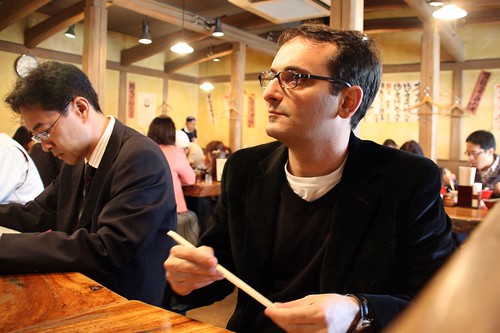

1 Comments:
Hey, eat more tarantulas and the like for me to put on my blog. Get a pic of you with a live suckling asp in your mouth or something.
Post a Comment
<< Home